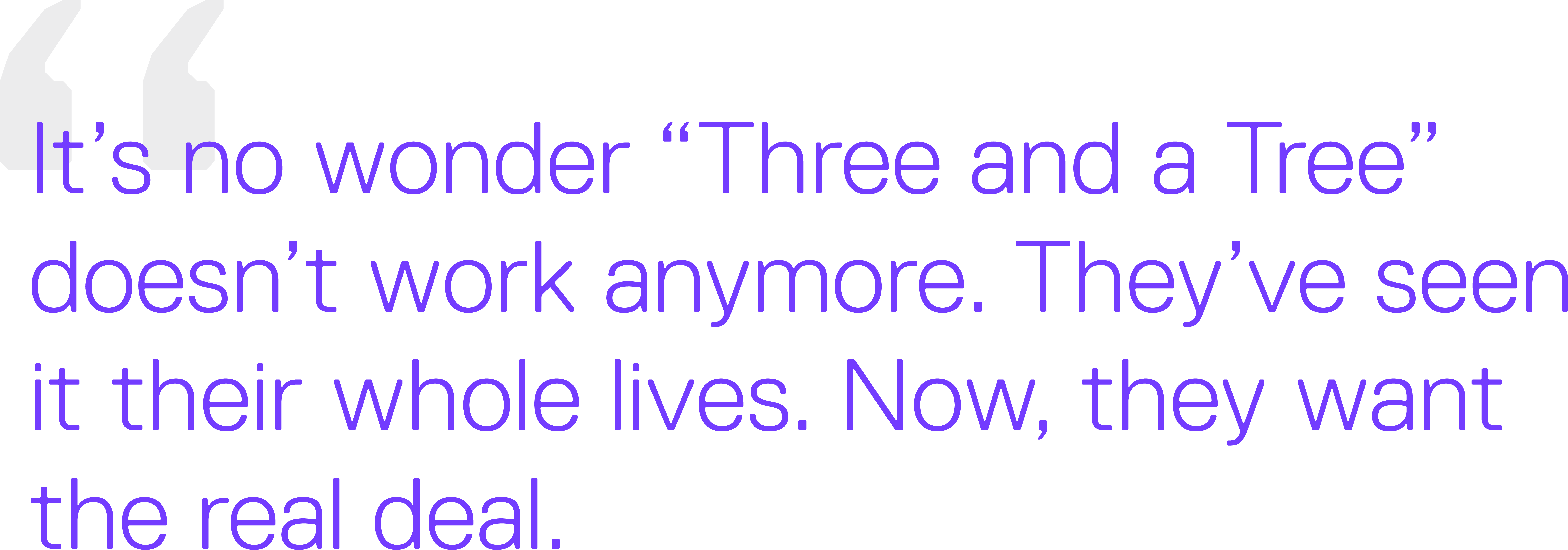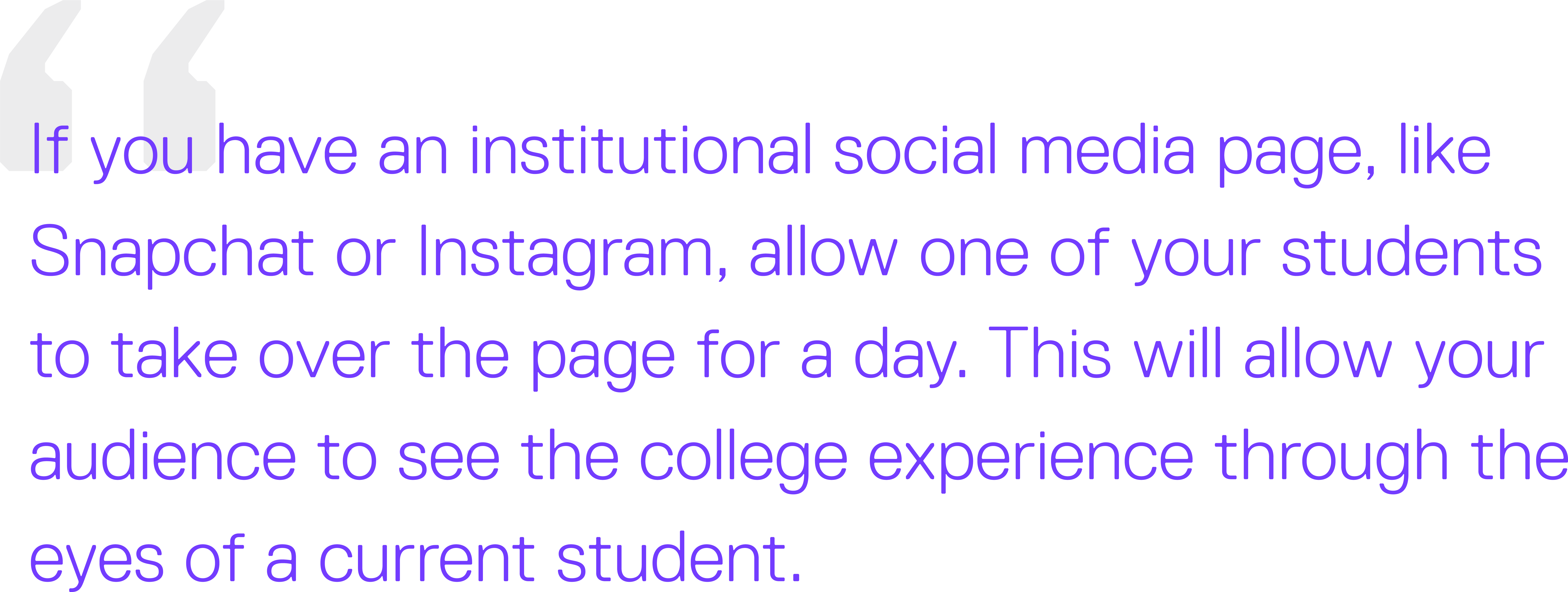As enrollment budgets get tighter and goals are set higher, college marketing to high school students has become the priority amongst many enrollment leaders. This group of students, also known as Generation Z, is determining the fate of many colleges and universities who lean heavily on enrollment numbers to financially support their institutions.
And what can be most difficult to grasp is the fact that these students weren’t even born yet when Will Smith was “Gettin’ Jiggy Wit It.”

That’s right. We’re talking about 17 and 18-year-olds.
So, how does an institution successfully market to this age group to ensure its survival?
Let’s consider the commonly-used marketing strategy described in Three and a Tree written by 160over90, an international branding agency headquartered in Philadelphia. How many times have you seen a college brochure with three happy, diverse college students sitting under a perfectly-bloomed tree placed in the most photographic location on campus? After counting the brochures in your head, that stack of brochures would be taller than the tree itself.

We’ve all done it. We’ve all used that same photo and have made it the focal point on our website landing pages and brochure covers. Some of us have even made it our brand identity. Even though it made our brochures prettier to open and our campus tour registration link inviting enough to click, it won’t be enough for today’s high school students to enroll.
As 160over90 states in their book, “A brand is a story, with a great hook at the beginning, a lot of meat in the middle, and a solid ending that makes the whole journey worthwhile. And it has to ring true.”
So what has changed with Generation Z? Why the need to focus on authenticity and abandon traditional marketing tactics?
According to a survey by Forbes, 74 percent of Generation Z spend their free time online. To go even further, another survey by The Drum noted that 78 percent of students surveyed said they use Snapchat daily. In fact, 71 percent said they use Snapchat more than six times per day, and 51 percent said they use Snapchat more than 11 times per day.
It’s no surprise that students are using social media much more frequently than ever before, but there is something about today’s social media that has changed the way students view the world. With social media outlets like Snapchat and Instagram, users are documenting their daily lives through their own eyes, and it’s without Photoshop and high-quality cameras. It’s through features like Snapchat and Instagram Stories where students can showcase their true selves, all with the ease of their smartphones. More importantly, they’re viewing their peers, and even their idols and favorite celebrities, like they never viewed them before: authentically.
Generation Z has always been online. By the time they went to elementary school, they were typing away on computers and already learning how to Google things. Because they were introduced so early to the World Wide Web (as it was once termed), they’ve also been introduced to every type of marketing gimmick under the sun. It’s no wonder “Three and a Tree” doesn’t work anymore. They’ve seen it their whole lives. Now, they want the real deal.
So, in an effort to retire the ever-so-favored posed campus photo, colleges and universities must look to other means and strategies of marketing to reach Generation Z. Here are some tips to authentically market to Generation Z:
Your current students can tell your true story better than anyone else, so let them.
Who better to learn about an institution from than current students themselves – they are living the experience as we speak! When prospective students are on campus, make sure your current students are showing them the way. Of course, it’s important that they meet with an admissions representative to gain the appropriate admissions and financial aid information, but it’s equally important that they pair up with current students who can host them around campus. They know the best meal in the dining hall and the best spot on campus to hang out with friends. Just with that alone, they have become an expert on your institution.
Invite your current students to help you in your online marketing efforts. Remember, this generation is more than willing to live on social media. If you have an institutional social media page, like Snapchat or Instagram, allow one of your students to take over the page for a day. This will allow your audience to see the college experience through the eyes of a current student.
A great example of this strategy was achieved by West Virginia University’s “Takeover Tuesday” campaign on Snapchat. Each Tuesday, the University selects a current student to document their day on campus. From getting out of bed, to sitting in class, followers of the Snapchat account were able to see what it’s like to live as a Mountaineer for a day.
“Allowing students to take over for the University is perfect; the students make up what the University is and represents and there is no better way to truly and honestly show that then letting students ‘takeover’ the various accounts,” said Layne Veneri, one of the students selected to takeover WVU’s Snapchat account.
Students want to talk to each other. So create the platform and watch the magic happen.
We’ve all learned that social media can connect people in ways they never could connect before, but Generation Z expects that concept in all facets of life. They experience it now in high school, they’ll demand it once they’re in college, but what about the in between? What about that crucial period between high school and college?

Tools like TargetX’s Schools App can bridge that communication gap by offering students the ability to connect with one another prior to their official enrollment. From targeted messaging to groups focused on certain student interests, admissions offices can create a platform that will allow students to feel connected to other students and the institution before they ever move into their dorm and walk to class. This can help generate that feeling of belonging and fitting in that Generation Z students so desperately crave.
Casey Thomas, Assistant Director of Digital Engagement at Arizona State University, found success with Schools App. After one year, ASU experienced double the engagement from prospective students.
“It has become so important for students to find friends before they even step foot on campus. Schools App is for students to not only ask their questions, but to build those friendships, so that it becomes more important for them to choose Arizona State University.”
Email isn’t going anywhere, so embrace it with the proper tools and techniques.
Though we know students are not checking their email as frequently as their Snapchat stories, email is the form of communication that will stand the test of time. Every social media account is connected to an email address, so you know Generation Z is checking email periodically. So, when they are checking it, how do you grab their attention?
Rather than sending a mass email with the traditional “Dear Student” header to all of your students, dig deeper to see what information you already have on the student. Does Sam want to major in biology? Is Sam from Indianapolis, Indiana? Does Sam want to play basketball in college? If you have that type of information, use it. By incorporating that information in an email, you are showing that you care about the student and will continue to care about them once they are on campus.
The way we communicate will forever evolve as new tools are created and embraced. In the meantime, we can learn from Generation Z by taking those three students on the cover of your brochures and asking them to tell their unique campus story, (and preferably not under a tree!).


